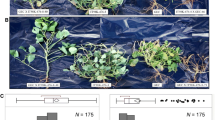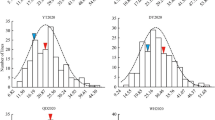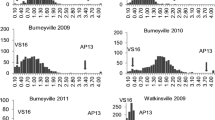Abstract
White clover (Trifolium repens L.) is a key component legume of temperate pasture agriculture and an important target for molecular marker-assisted plant breeding. A genetic map of white clover has been used to assess genetic control of agronomically important traits that vary in the F2(I.4R×I.5J) mapping family. Phenotypic analysis was performed for a range of vegetative morphogenesis traits (such as leaf area, internode length, plant height and plant spread) and reproductive morphogenesis and development traits (such as flowering date, floral intensity and seed yield), with both spatial and temporal replication. A multi-environment combined analysis (combined analysis) has been performed for traits assessed across multiple experimental datasets in order to identify consistent genetic effects. Quantitative trait locus (QTLs) were detected for the majority of traits, and the locations and magnitudes of QTL effects were compared between individual and combined analyses. This molecular genetic dissection of agronomic traits in white clover provides the basis for equivalent studies in more complex populations, design of marker-assisted selection strategies and comparative genetics with model legume species. Selection for QTLs derived from the combined analysis will permit robust improvement of phenotypic traits over different environments.





Similar content being viewed by others
References
Allard RW (1960) Principles of plant breeding. Wiley, London, p 485
Andersen JR, Lübberstedt T (2003) Functional markers in plants. Trends Plant Sci 8:554–560
Atwood SS (1940) Genetics of cross-incompatibility among self-incompatible plants of Trifolium repens L. J Am Soc Agron 32:955–968
Atwood SS, Hill HD (1940) The regularity of meiosis in microsporocytes of Trifolium repens. Am J Bot 27:730–735
Barcikowska B (1976) Studies on some utility features of the crosses Trifolium repens L. form cultum and relationships between clones and their generative progeny. Genet Pol 17:191–210
Barrett B, Griffiths A, Schreiber M, Ellison N, Mercer C, Bouton J, Ong B, Forster J, Sawbridge T, Spangenberg G, Bryan G, Woodfield D (2004) A microsatellite map of white clover (Trifolium repens L.). Theor Appl Genet 109:596–608
Barrett B, Baird IJ, Woodfield DR (2005) A QTL analysis of white clover seed production. Crop Sci 45:1844–1850
Basten CJ, Weir BS, Zeng Z-B (1994) Zmap-a QTL cartographer. In: Smith C, Gavora JS, Chesnais BBJ, Fairfull W, Gibson JP, Kennedy BW, Burnside EB (eds) Proceedings of the 5th world congress on genetics applied to livestock production: computing strategies and software, vol 22. Guelph, Ontario, Canada, pp 65–66
Beavis WD (1994) The power and deceit of QTL experiments: lessons from comparative QTL studies. In: The proceedings of the forty-ninth annual corn and sorghum industry research conference. American Seed Trade Association, Washington, DC, pp 250–266
Bert P-F, Jouan I, Tourvieille de Labrouhe D, Serre F, Philippon J, Nicolas P, Vear F (2003) Comparative genetic analysis of quantitative traits in sunflower (Helianthus annus L.). 2. Characterisation of QTL involved in developmental and agronomic traits. Theor Appl Genet 107:181–189
Bolanos-Aguilar ED, Huyghe C, Djukic D, Julier B, Ecalle C (2001) Genetic control of alfalfa seed yield and its components. Plant Breed 120:67–72
Bolanos-Aguilar ED, Huyghe C, Ecalle C, Hacquet J, Julier B (2002) Effect of cultivar and environment on seed yield in alfalfa. Crop Sci 42:45–50
Bonnin I, Prosperi J-M, Oliveri I (1996) Genetic markers and quantitative genetic variation in Medicago truncatula (Leguminosae): a comparative analysis of population structure. Genetics 143:1795–1805
Bonnin I, Prosperi J-M, Oliveri I (1997) Comparison of quantitative genetic parameters between two natural populations of a selfing plant species, Medicago truncatula Gaertn
Brigham RD, Wilsie CP (1955) Seed setting and vegetative vigour of Ladino clover (Trifolium repens Leyss.) clones and their diallel crosses. Agron J 47:125–127
Caradus JR, Chapman DF (1996) Selection for and heritability of stolon characteristics in two cultivars of white clover. Crop Sci 36:900–904
Caradus JR, Mackay AC (1991) Performance of white clover cultivars and breeding lines in a mixed species sward. II. Plant characters contributing to differences in clover proportion in swards. NZ J Agr Res 34:155–160
Caradus JR, Williams WM (1981) Breeding for improved white clover production in New Zealand hill country. In: Plant physiology and herbage production. Br Grassl Soc Occ Symp No. 13, British Grasslands Society, Nottingham, UK, pp 163–168
Caradus JR, Woodfield DR (1990) Estimates of heritability for, and relationships between, root and shoot characters of white clover. 1. Replicated clonal material. Euphytica 46:203–209
Choi H-K, Kim D-J, Uhm T, Limpens E, Lim H, Mun J-H, Kalo P, Varma Penmetsa R, Seres A, Kulikova O, Roe BA, Bisseling T, Kiss GB, Cook DR (2004a) A sequence-based genetic map of Medicago truncatula and comparison of marker colinearity with M. sativa. Genetics 166:1463–1502
Choi H-K, Mun J-H, Kim D-J, Zhu H, Baek J-M, Mudge J, Roe B, Ellis N, Doyle J, Kiss GB, Young ND, Cook DR (2004b) Estimating genome conservation between crop and model legume species. Proc Natl Acad Sci USA 43:15289–15294
Churchill GA, Doerge RW (1994) Empirical threshold values for quantitative trait mapping. Genetics 138:963–971
Clements RJ, Hayward MD, Byth DE (1983) Genetic adaptation in pasture plants. In: McIvor JG, Bray RA (eds) Genetic resources of forage plants. CSIRO, Australia, pp 101–106
Collins RP, Abberton MT, Michaelson-Yeates TPT, Rhodes I (1997) Response to divergent selection for stolon characters in white clover (Trifolium repens). J Agric Sci 129:279–285
Collins RP, Abberton MT, Michaelson-Yeates TPT, Marshall AH, Rhodes I (1998) Effects of divergent selection between morphological traits in white clover (Trifolium repens L.). Euphytica 101: 301–305
Collins RP, Helgadottir A, Fothergill M, Rhodes I (2002) Variation amongst survivor populations of white clover collected from sites across Europe: growth attributes and physiological responses to low temperature. Ann Bot 89:283–292
Connolly V (1990) Seed yield and yield components in ten white clover cultivars. Irish J Agric Res 29:41–48
Crush JR (1987) Nitrogen fixation. In: Williams WM (ed) White clover. CAB International, Wallingford, pp 185–201
Cullis BR, Gogel BJ, Morris SG, Verbyla AP, Thompson R (1998) Spatial analysis of multi-environment early generation trials. Biometrics 54:1–18
Davies WE (1958) The yields of pure sown plots of eight white clover strains under cutting. J Brit Grassl Soc 13:34–38
Doerge RW, Churchill GA (1996) Permutation tests for multiple loci affecting a quantitative character. Genetics 142:285–294
Frame J, Charlton JFL, Laidlaw AS, (1998) Temperate forage legumes. CAB International, Wallingford, p 327
GENSTAT Committee (2003) GenStat® Release 7.1. VSN International Ltd, Oxon
Gibson PB (1957) Effects of flowering on the persistence of white clover. Agron J 49:213–215
Grattapaglia D, Bertolucci FL, Sederoff RR (1995) Genetic mapping of QTLs controlling vegetative propagation in Eucalyptus grandis and E. urophylla using a pseudo-testcross strategy and RAPD markers. Theor Appl Genet 90:933–947
Haley CS, Knott SA (1992) A simple regression method for mapping quantitative trait loci in line crosses using flanking markers. Heredity 69:315–324
Hay MJM, Newton PCD (1996) Effect of severity of defoliation on the viability of reproductive and vegetative axillary buds of Trifolium repens L. Ann Bot 78:117–123
Jones ES, Hughes LJ, Drayton MC, Abberton MT, Michaelson-Yeates TPT, Bowen C, Forster JW (2003) An SSR and AFLP molecular marker-based genetic map of white clover (Trifolium repens L.). Plant Sci 165:447–479
Juan NA, Sheaffer CC, Barnes DK, Swanson DR, Halgerson JH (1993) Leaf and stem traits and herbage quality of multifoliolate alfalfa. Agron J 85:1121–1127
Kajita T, Ohashi H, Tateishi Y, Bailey CD, Doyle JJ (2001) rbcL and legume phylogeny, with particular reference to Phaseoleae, Millettieae, and allies. Syst Biol 26:515–536
Kawanabe S, Yoshihara K, Okada T, Ueno M, Hidaka M (1963) Studies on summer depression of pasture crops. 3. Influence of flower bud removal upon vegetative growth of Ladino clover. J Jpn Soc Grass Soc 9:31–41
Kearsey MJ, Farquhar AGL (1998) QTL analysis in plants; where are we now? Heredity 80:137–142
Kimbeng CA, Bingham ET (1998) Population improvement in lucerne (Medicago sativa L.): components of inbreeding depression are different in original and improved populations. Aust J Exp Agric 38:831–836
Lan T-H, Paterson AH (2001) Comparative mapping of QTLs determining the plant size of Brassica oleracea. Theor Appl Genet 103:383–397
Lander ES, Botstein D (1989) Mapping Mendelian factors underlying quantitative traits using RFLP linkage maps. Genetics 121:185–199
Li ZK, Yu SB, Lafitte HR, Huang N, Courtois B, Hittalmani S, Vijayakumar CHM, Liu GF, Wang GC, Shashidhar HE, Zhuang JY, Zheng KL, Singh VP, Sidhu JS, Srivantaneeyakul S, Khush GS (2003) QTL × environments in rice. I. Heading date and plant height. Theor Appl Genet 108:141–154
Li Y, Sorefan K, Hemmann G, Bevan MW (2004) Arabidopsis NAP and PIR regulate actin-based cell morphogenesis and multiple developmental processes. Plant Physiol 136:3616–3627
McCouch SR, Cho YG, Yano M, Paul E, Blinstrub M, (1997) Report on QTL nomenclature. Rice Genet Newsl 14:11–13
Michaelson-Yeates TPT, Marshall A, Abberton MT, Rhodes I, (1997) Self-incompatibility and heterosis in white clover (Trifolium repens L.). Euphytica 94:341–348
Nyquist WE (1991) Estimation of heritability and prediction of selection response in plant populations. Crit Rev Plant Sci 10:235–322
Pedrosa A, Sandal N, Stougaard J, Schweizer D, Bachmair A (2002) Chromosomal map of the model legume Lotus japonicus. Genetics 161:1661–1672
Pérez-Pérez JM, Serrano-Cartagena J, Micol JL, (2002) Genetic analysis of natural variations in the architecture of Arabidopsis thaliana vegetative leaves. Genetics 162:893–915
Piano E, Annicchiarico P (1995) Persistence of Ladino white clover ecotypes and its relationship with other agronomic traits. Grass Forage Sci 50:195–198
Rhodes I, Collins RP, Evans DR (1994) Breeding white clover for tolerance to low temperature and grazing Euphytica 77:239–242
Sandal N, Krusell l, Radutoi S, Olbryt M, Pedrosa A, Stracke S, Sato S, Kato T, Tabata S, Parniske M, Bachmair A, Ketelsen T, Stougaard J (2002) A genetic linkage map of the model legume Lotus japonicus and strategies for fast mapping of new loci. Genetics 161:1673–1683
Schön CC, Utz HF, Groh S, Truberg B, Openshaw S, Melchinger AE (2004) Quantitative trait locus mapping based on resampling in a vast Maize testcross experiment and its relevance to quantitative genetics for complex traits. Genetics 167:485–498
Sebastian RL, Kearsey MJ, King GJ (2002) Identification of quantitative trait loci controlling developmental characteristics of Brassica oleracea L. Theor Appl Genet 104:601–609
Ungerer MC, Halldorsdottir SS, Modliszewski JL, Mackay TFC, Purugganan MD (2002) Quantitative trait loci for inflorescence development in Arabidopsis thaliana. Genetics 160:1133–1151
Ungerer MC, Halldorsdottir SS, Purugganan MD, Mackay TFC (2003) Genotype-environment interactions at quantitative trait loci affecting inflorescence development in Arabidopsis thaliana. Genetics 165:353–365
Van Bogaert G (1977) Factors affecting seed yield in white clover. Euphytica 26:233–239
Vandenbosch KA, Stacey G (eds) (2003) Summaries of legume genomics projects from around the globe. Community resources for crops and models. Plant Physiol 131:840–865
Via S, Gomulkiewicz R, DeJong G, Scheiner SM, Schlichting CD, Vantienderen PH (1995) Adaptive phenotypic plasticity—consensus and controversy. Trends Ecol Evol 10:212–217
Williams WM (1987) Genetics and breeding. In: Williams WM (eds) White clover. CAB International, Wallingford, pp 343–419
Williams TA, Abberton MT, Thornley WJ, Evans DR, Rhodes I (1998) Evaluation of seed production potential in white clover (Trifolium repens L.) varietal improvement programs. Grass Forage Sci 53:197–207
Woodfield DR, Caradus JR, (1990) Estimates of heritability for, and relationships between, root and shoot characteristics of white clover. II. Regression of progeny on mid-parents. Euphytica 46:211–215
Woodfield DR, Caradus JR,(1994) Genetic improvement in white clover representing six decades of plant breeding. Crop Sci 34:1205–1213
Xu S, (2003) Theoretical basis of the Beavis effect. Genetics 165:2259–2268
Zeng Z (1994) Precision mapping of quantitative trait loci. Genetics 136:1457–1468
Acknowledgements
This work was supported by the Victorian Department of Primary Industries, Dairy Australia, the Geoffrey Gardiner Dairy Foundation, Meat and Livestock Australia and the Molecular Plant Breeding Cooperative Research Centre, Australia. The Biotechnological and Biological Sciences Research Council and Department of Environment, Food and Rural Affairs provided support in the United Kingdom. The scientific advice of Prof. Michael Hayward (Rhydgoch Genetics, Aberystwyth, UK) and Prof. German Spangenberg is gratefully acknowledged.
Author information
Authors and Affiliations
Corresponding author
Additional information
Communicated by G. Wenzel
Electronic supplementary material
Rights and permissions
About this article
Cite this article
Cogan, N.O.I., Abberton, M.T., Smith, K.F. et al. Individual and multi-environment combined analyses identify QTLs for morphogenetic and reproductive development traits in white clover (Trifolium repens L.). Theor Appl Genet 112, 1401–1415 (2006). https://doi.org/10.1007/s00122-006-0241-2
Received:
Accepted:
Published:
Issue Date:
DOI: https://doi.org/10.1007/s00122-006-0241-2




